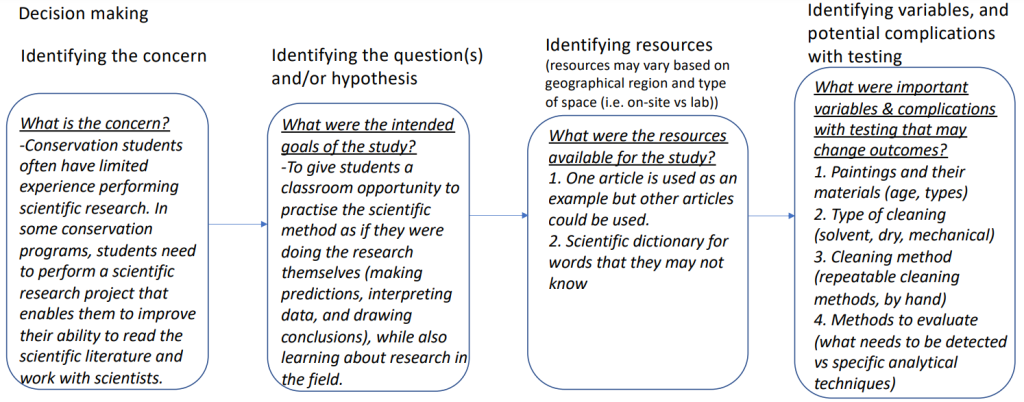Research Design: Using the Interrupted Case Method
Alison Murray
1. Author’s Information & Abstract
Author’s Information
Alison Murray, Art Conservation Program, Department of Art History and Art Conservation, Queen’s University, Kingston, Ontario, Canada, K7L 3N6; alison.murray@queensu.ca
Publishing Information
Published March 2024
Abstract
Conservation students often have limited experience in research design. They need opportunities to practise thinking of research questions and how the goals of the research can be investigated. This module is an introduction to research that can be performed during a lecture: students can develop overarching research questions, pinpoint specifics that need to be tested, and start to think about constraining variables.
2. Introduction
Hypothesis
Students will be more able to design their own research projects with the experience of studying a published article in class using the Interrupted Case Method. Students develop research questions, determine what observations and experiments are needed, imagine possible results, and determine the conclusions and ramifications before reading sections from the original researchers’ paper. Using the Interrupted Case Method creates a problem-solving exercise for the students, engaging the students more fully, as if they were actually performing the experiment.
Threshold concept
Research design
Major Goals and Outcomes
Students will:
-Experience the scientific method in the classroom.
-Design an experiment, make predictions, and interpret data.
-Describe how scientists solve research questions.
-Discuss and decrease their apprehensions about performing research.
3. References
Overview of Interrupted Case Study Method
Herreid, Clyde Freeman. 2007. “The Interrupted Case Method.” In Start with a Story: The Case Study Method of Teaching College Science, edited by Clyde Freeman Herreid, 169-170. Arlington: National Science Teachers Association Press.
Herreid, Clyde Freeman. 2007. “Mom Always Liked You Best. Examining the Hypothesis of Parental Favoritism.” In Start with a Story: The Case Study Method of Teaching College Science, edited by Clyde Freeman Herreid, 171-177. Arlington: National Science Teachers Association Press.
Paper Used for Interrupted Case Study
White, Raymond and Ashok Roy. 1998. “Studies on the effects of Solvent Cleaning on Old Master Paintings from the National Gallery, London.” Studies in Conservation, 43 (3): 159-176.
4. Case Study
White, Raymond and Ashok Roy. “Studies on the effects of Solvent Cleaning on Old Master Paintings from the National Gallery, London.” Studies in Conservation, 43 (3): 159-176.
A Brief Description of the Scenario
-Students are given sections of a paper over the course of one class (Handouts for Case Study- Murray) and follow up with discussions.
Handouts for Case Study – Murray
Slide 1 – Introduction
The instructor gives an overview of the background found in the Introduction (slide 1), which the students also read. Students are then asked to discuss the following in groups:
- The specific questions the researchers could be investigating;
- The possible hypotheses of the researchers;
- The predictions for the research if the hypothesis is true; and
- How the predictions can be tested.
(15 minutes)
The student groups then report to the whole class.
Slide 2 – Redacted Abstract
The instructor discusses the Redacted Abstract, which the students also read (slide 2). Students then need to design an experiment that considers what the researchers might have done (10 minutes).
The student groups then report to the whole class.
Slide 3 – Overview of Experimental Work
The instructor gives an overview of the experiment the researchers performed, which the students also read (slide 3). Students are then asked to discuss what the data might show (5 minutes).
The student groups then report to the whole class.
Slide 4 – Results
The instructor shows the class some of the results and the students also read this information (slide 4).
Students are asked to predict the missing data if the researchers’ hypothesis was 1) correct or 2) incorrect. (10 minutes)
The student groups then report to the whole class.
Slide 5 – Conclusions
The instructor will discuss the conclusions (slide 5) and students have the information to read.
Students are asked to compare the paper’s conclusions to their predictions. What can be stated about the hypotheses? (10 minutes)
The student groups then report to the whole class.
Decision Making Figure

5. Challenges
Students may not feel comfortable discussing potential analytical techniques because of their limited experience; however, the discussion can focus on what they believe needs to be determined (ex. the material properties needing to be investigated). The instructor needs to be sure to leave pauses for the students to speak.


Feedback/Errata